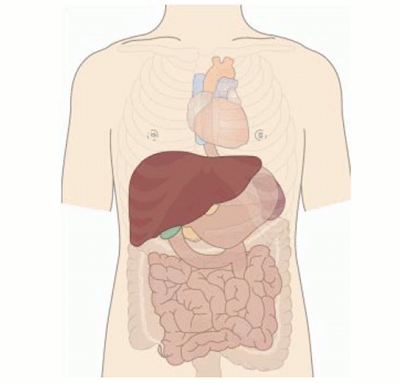
 |
|
|
 Alcohol and the liver
Alcohol and the liver
The liver is the largest gland, and the largest solid organ in the body, weighing an average of 1.8 kgs in men and 1.3 kgs in women. It holds approximately 13% (about one pint or 0.57 litres) of your total blood supply at any given moment and is estimated to have over 500 functions. One of the many jobs it has to deal with is breaking down, or ‘metabolising’, the alcohol you drink.
How does the liver break down alcohol?
Alcohol is quickly soaked up through the lining of the stomach and the upper part of the gut (intestine) and into your blood stream. The higher the concentration of alcohol, the faster it will be absorbed (food slows absorption and allows the enzyme ADH found in the stomach to start breaking down alcohol, helping the liver). From there, the alcohol is carried to your liver as well as other organs and body tissue.
Your liver cannot store alcohol. It metabolises about 90 per cent of the alcohol you drink, (the rest is excreted through your urine and sweat). Your liver can process about 10g - or a small drink an hour, any remaining alcohol circulates in your blood until it can be broken down - this is how ‘blood alcohol concentration’ is assessed for drink drive limits, for example.
Your liver needs water to do its job, because alcohol acts as a diuretic (it makes you pass urine) so it dehydrates you. When the liver is processing alcohol it converts ethanol into a toxic substance called acetaldehyde. Acetaldehyde is subsequently broken down into a harmless chemical called acetate, which is broken down further into carbon dioxide and water, which are excreted via the normal route!
Alcohol related liver disease
Regular heavy drinking over time can strain or disrupt this process. The liver has become known as ‘the canary of drinking’ i.e. it becomes damaged if you drink excessively. Due to its huge functional reserve, fatty liver or cirrhosis can often be advanced before symptoms arise - hence liver disease is known as ‘a silent disease’.
Drinking too much alcohol over a long period harms the liver and makes it very fatty, with the liver cells becoming bloated. This can result in swelling and inflammation of the liver – known as alcoholic hepatitis or alcoholic steatohepatitis – and can lead to scarring, known as fibrosis. Extensive scarring, combined with development of nodules, is known as cirrhosis (affecting between 10% and 35% of excessive drinkers) - a disease we have all come to associate with heavy long term drinking of alcohol.
Liver specialists identify the following two groups as at a high risk of developing serious types of alcoholic liver disease: Men who drink more than 20 drinks a week for 10 years or more Women who drink more than 16 drinks a week for 10 years or more.In the United States, there are an estimated 33,642 deaths per year due to liver disease. 16,749 were alcohol-related. Other causes of liver disease include chronic hepatitis B and C infection, non-alcoholic fatty liver disease, and liver cancer.
What is Liver Disease? (Click for more information)
For more information and support visit
The American Liver Foundation: www.liverfoundation.org
Please visit the gateway to sensible drinking and health, alcoholinmoderation.com for specific studies and summary papers.